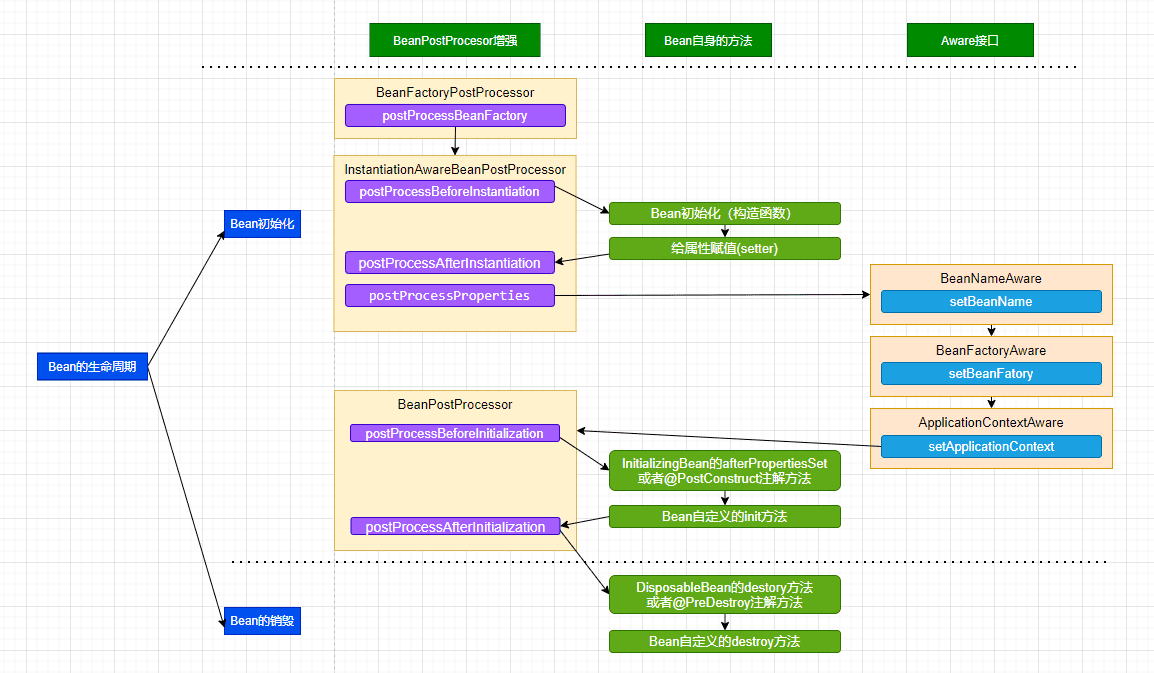静态工具类初始化引用配置
与第三方做交互时,封装了一个HttpUtil,由于开发和测试的地址不一样,所以准备将对应的一些属性写在配置文件里, 但是 Util 嘛,还是想通过静态方法调用,那么我们能不能将配置文件的属性读取到工具类的静态方法呢?
spring 生命周期
Bean的完整生命周期经历了各种方法调用,这些方法可以划分为以下几类:
Bean自身的方法:包括Bean本身调用的方法和通过配置文件中< bean>的init-method和destroy-method指定的方法。
Bean级生命周期接口方法: 包括BeanNameAware、BeanFactoryAware、ApplicationContextAware,也包括InitializingBean和DiposableBean这些接口的方法(可以被@PostConstruct和@PreDestroy注解替代)。
容器级生命周期接口方法: 包括InstantiationAwareBeanPostProcessor 和 BeanPostProcessor 两个接口实现,一般称它们的实现类为“后处理器”。
工厂后处理器接口方法: 包括AspectJWeavingEnabler, ConfigurationClassPostProcessor, CustomAutowireConfigurer等非常有用的工厂后处理器接口的方法。工厂后处理器也是容器级的。在应用上下文装配配置文件之后立即调用。

具体流程如下:
-
如果 BeanFactoryPostProcessor 和 Bean 关联, 则调用postProcessBeanFactory方法.(即首先尝试从Bean工厂中获取Bean)
-
如果 InstantiationAwareBeanPostProcessor 和 Bean 关联,则调用postProcessBeforeInstantiation方法
-
根据配置情况调用 Bean 构造方法实例化 Bean。
-
利用依赖注入完成 Bean 中所有属性值的配置注入。
-
如果 InstantiationAwareBeanPostProcessor 和 Bean 关联,则调用postProcessAfterInstantiation方法和postProcessProperties
-
调用xxxAware接口 (上图只是给了几个例子)
-
第一类Aware接口
-
如果 Bean 实现了 BeanNameAware 接口,则 Spring 调用 Bean 的 setBeanName() 方法传入当前 Bean 的 id 值。
-
如果 Bean 实现了 BeanClassLoaderAware 接口,则 Spring 调用 setBeanClassLoader() 方法传入classLoader的引用。
-
如果 Bean 实现了 BeanFactoryAware 接口,则 Spring 调用 setBeanFactory() 方法传入当前工厂实例的引用。
-
-
第二类Aware接口
-
如果 Bean 实现了 EnvironmentAware 接口,则 Spring 调用 setEnvironment() 方法传入当前 Environment 实例的引用。
-
如果 Bean 实现了 EmbeddedValueResolverAware 接口,则 Spring 调用 setEmbeddedValueResolver() 方法传入当前 StringValueResolver 实例的引用。
-
如果 Bean 实现了 ApplicationContextAware 接口,则 Spring 调用 setApplicationContext() 方法传入当前 ApplicationContext 实例的引用。
-
-
-
如果 BeanPostProcessor 和 Bean 关联,则 Spring 将调用该接口的预初始化方法 postProcessBeforeInitialzation() 对 Bean 进行加工操作,此处非常重要,Spring 的 AOP 就是利用它实现的。
-
如果 Bean 实现了 InitializingBean 接口,则 Spring 将调用 afterPropertiesSet() 方法。(或者有执行@PostConstruct注解的方法), 在此处可以进行静态类的属性配置
-
如果在配置文件中通过 init-method 属性指定了初始化方法,则调用该初始化方法。
-
如果 BeanPostProcessor 和 Bean 关联,则 Spring 将调用该接口的初始化方法 postProcessAfterInitialization()。此时,Bean 已经可以被应用系统使用
-
如果在 < bean> 中指定了该 Bean 的作用范围为 scope=“singleton”,则将该 Bean 放入 Spring IoC 的缓存池中,将触发 Spring 对该 Bean 的生命周期管理;如果在 < bean> 中指定了该 Bean 的作用范围为 scope=“prototype”,则将该 Bean 交给调用者,调用者管理该 Bean 的生命周期,Spring 不再管理该 Bean。
-
如果 Bean 实现了 DisposableBean 接口,则 Spring 会调用 destory() 方法将 Spring 中的 Bean 销毁;(或者有执行@PreDestroy注解的方法)
-
如果在配置文件中通过 destory-method 属性指定了 Bean 的销毁方法,则 Spring 将调用该方法对 Bean 进行销毁。
了解了spring生命周期后,开始进行实践,以如下配置为例,在静态类中打印配置文件的属性。
server: ?port: 36321 ?servlet: ? ?context-path: /
属性类,进行配置文件属性的注入
import lombok.Data;
import org.springframework.beans.factory.annotation.Value;
import org.springframework.stereotype.Component;
?
@Data
@Component
public class RequestProperty {
?
? ?@Value("${server.port}")
? ?public String port;
?
? ?@Value("${server.servlet.context-path}")
? ?public String contextPath;
?
? ?public static String NAME = "name";
?
}
静态类实现InitializingBean, ApplicationContextAware接口,进行属性的初始化(实例注入)
?
import org.springframework.beans.BeansException;
import org.springframework.beans.factory.InitializingBean;
import org.springframework.context.ApplicationContext;
import org.springframework.context.ApplicationContextAware;
import org.springframework.stereotype.Component;
?
@Component
public class PropertiesUtil implements InitializingBean, ApplicationContextAware {
?
? ?private static ApplicationContext applicationContext;
?
? ?private static RequestProperty perporty;
?
? ?@Override
? ?public void afterPropertiesSet() {
? ? ? ?perporty = applicationContext.getBean(RequestProperty.class);
? }
?
? ?@Override
? ?public void setApplicationContext(ApplicationContext applicationContext) throws BeansException {
? ? ? ?this.applicationContext = applicationContext;
? }
?
? ?public static void printProperty() {
? ? ? ?System.out.println("*********打印配置属性开始*******");
? ? ? ?System.out.println(perporty.getPort());
? ? ? ?System.out.println(perporty.getContextPath());
? ? ? ?System.out.println(RequestProperty.NAME);
? ? ? ?System.out.println("*********打印配置属性结束*******");
? }
?
}
测试类,调用静态类的静态方法
方式一:定时任务调用
?
import org.springframework.scheduling.annotation.EnableScheduling;
import org.springframework.scheduling.annotation.Scheduled;
import org.springframework.stereotype.Component;
?
@EnableScheduling
@Component
public class SpringBeanTask {
?
? ?@Scheduled(fixedRate = 10000)
? ?public void excute() {
? ? ? ?PropertiesUtil.printProperty();
? }
?
}
方式二: 监听 spring 容器启动
?
import org.springframework.boot.ApplicationArguments;
import org.springframework.boot.ApplicationRunner;
import org.springframework.stereotype.Component;
?
?
/**
* 监听Spring容器启动完成,完成后执行属性打印
**/
@Component
public class ProertiesUtilListener implements ApplicationRunner {
?
? ?@Override
? ?public void run(ApplicationArguments args) throws Exception {
? ? ? ?PropertiesUtil.printProperty();
? }
? ?
}
本文来自互联网用户投稿,该文观点仅代表作者本人,不代表本站立场。本站仅提供信息存储空间服务,不拥有所有权,不承担相关法律责任。 如若内容造成侵权/违法违规/事实不符,请联系我的编程经验分享网邮箱:chenni525@qq.com进行投诉反馈,一经查实,立即删除!
- Python教程
- 深入理解 MySQL 中的 HAVING 关键字和聚合函数
- Qt之QChar编码(1)
- MyBatis入门基础篇
- 用Python脚本实现FFmpeg批量转换
- 代码随想录算法训练营day3|203.移除链表元素、707.设计链表、206.反转链表
- 在IDEA中配置Git的Push键
- C++ //练习 2.35 判断下列定义推断出的类型是什么,然后编写程序进行验证。
- Mysql的聚簇索引(聚集索引)和非聚簇索引的区别
- java实现菜单树
- three.js实现雷达扫描效果(纹理贴图)
- 自然语言处理的就业前景
- 河北移动与中兴通讯现已规模部署5G AAU自动启停功能
- 第11章_常用类和基础API拓展练习(字符串相关练习,日期时间API练习,比较器练习,其它API练习)
- 关于 open ai,你了解多少?